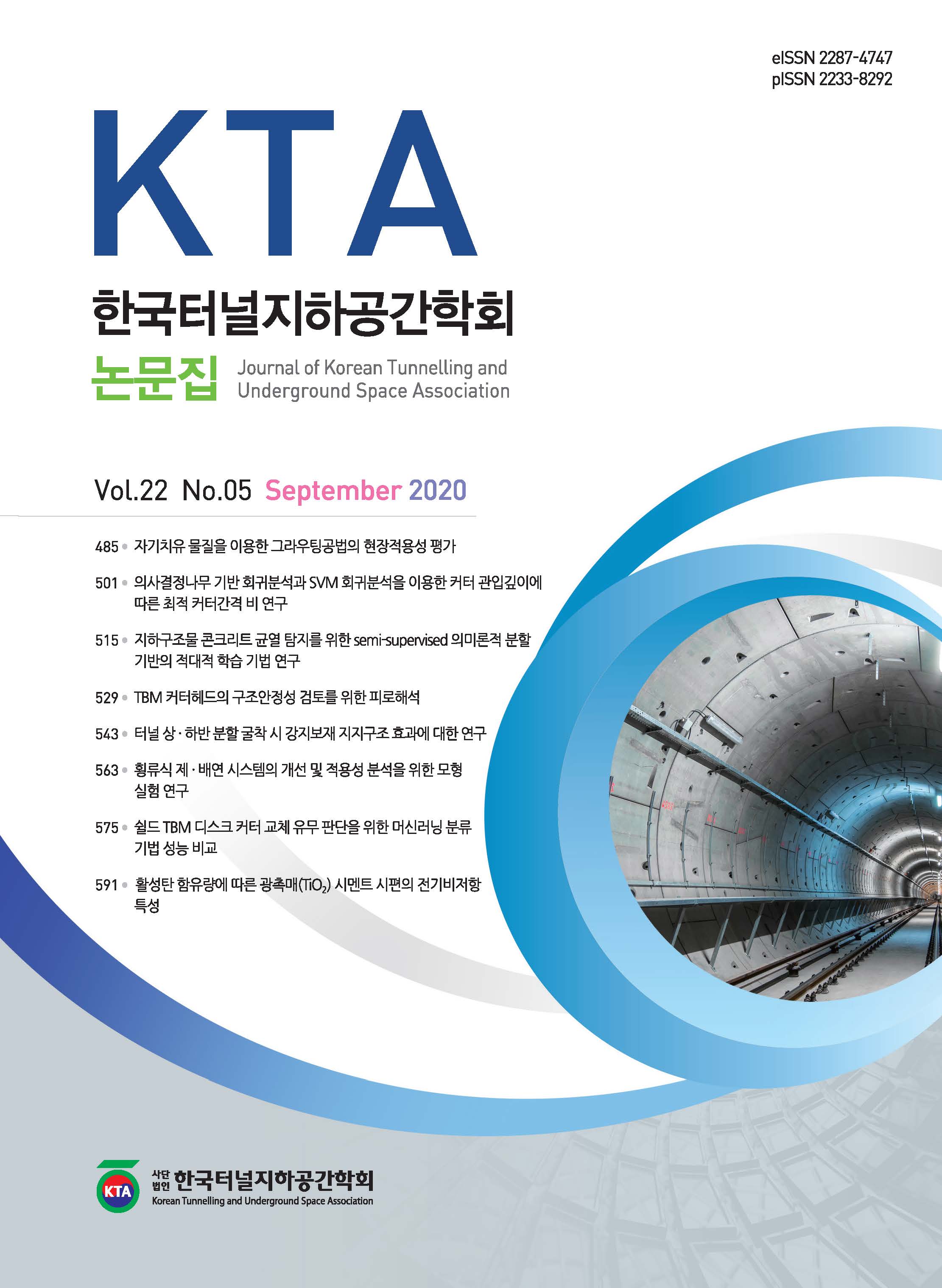- 권한신청
- P-ISSN2233-8292
- E-ISSN2287-4747
- KCI
 ISSN : 2233-8292
ISSN : 2233-8292
신설터널의 위치에 따른 기존 병렬터널의 영향 분석
Analysis of the influence of existing parallel tunnels according to the location of the new tunnel
김한얼 (한양대학교)
남경민 (한양대학교)
정예림 (한양대학교(ERICA캠퍼스))
조재은 (한양대학교(ERICA캠퍼스))
유한규 (한양대학교)
- 다운로드 수
- 조회수
초록
최근 지상구조물이 포화상태에 이르렀고 증가하는 교통난과 환경문제를 해결하기 위한 방안으로 터널과 같은 지하구조 물을 활용한 지하화 건설이 각광 받고 있다. 그러나 증가하는 지하구조물로 인해 지속적인 지하화 개발을 위해서는 근접 시공이 불가피한 상황이다. 새로운 지하구조물을 근접 시공할 시 기존구조물에 미치는 영향으로 인해 안정성이 취약해져 붕괴를 일으킬 수 있다. 따라서 기존구조물의 안정성을 분석하는 것은 필수적으로 고려해야 하는 사항이다. 본 연구에서는 지하구조물인 병렬터널의 하부에 신설터널을 굴착하여 근접시공으로 인한 기존 병렬터널에 미치는 영향을 수치해석을 사용하여 분석하였다. 변위조절모델(Displacement Control Model, DCM)을 이용하여 시공 시 발생하는 지반손실률을 세 가지(0.5%, 1.0%, 1.5%)로 모사하였다. 필라 중심을 기준으로 신설터널이 위치하는 거리를 5 m, 6 m, 7 m, 8m, 9 m로 설정하고 각 거리별로 간격을 5가지(0D1, 0.37D1, 0.75D1, 1.13D1, 1.5D1)로 설정하였다. 일반적으로 지반손실률이 증가하고 거리가 근접할수록 최대변위, 각변위가 증가하였고 필라의 안정성을 평가하는 강도/응력비 또한 감소하였다. 결과적으로 신설터널과 필라 중심과의 거리가 5 m, 간격이 0D1, 지반손실률이 1.5%인 경우 기존 병렬터널의 안정성이 가장 취약한 것으로 나타났다.
- keywords
- 병렬터널, 변위, 강도/응력비, 지반손실률, 변위조절모델, Parallel tunnels, Displacement, Strength-stress ratio, Volume loss, Displacement control model
Abstract
Recently, ground structures have reached saturation, and underground construction using underground structures such as tunnels has been in the spotlight as a way to solve increasing traffic difficulties and environmental problems. However, due to the increasing number of underground structures, close construction is inevitable for continuousunderground development. When a new underground structure is constructed closely, stability may become weak due to the influence on the existing tunnel, which may cause collapse. Therefore, analyzing the stability of existing tunnels due to new structures is an essential consideration. In this study, the effect of excavating new tunnels under parallel tunnels on existing parallel tunnels was analyzed using numerical analysis. Using the Displacement Control Model (DCM), the volume loss generated during construction was simulated into three case (0.5%, 1.0%, and 1.5%). Based on the center of the pillar, the distance where the new tunnel is located was set to 5 m, 6 m, 7 m, 8 m, 9 m, and the space for each distance were set to 5 (0D1, 0.37D1, 0.75D1, 1.13D1, 1.5D1). In general, as the volume loss increased and the distance approached, the maximum displacement and angular displacement increased, and the strength/stress ratio toevaluate the stability of the pillar also decreased. As a result, when the distance between the new tunnel and the center of the pillar is 5 m, the space is 0D1, and the volume loss is 1.5%, the stability of the existing parallel tunnel is the weakest.
- keywords
- 병렬터널, 변위, 강도/응력비, 지반손실률, 변위조절모델, Parallel tunnels, Displacement, Strength-stress ratio, Volume loss, Displacement control model
- 다운로드 수
- 조회수
- 0KCI 피인용수
- 0WOS 피인용수

